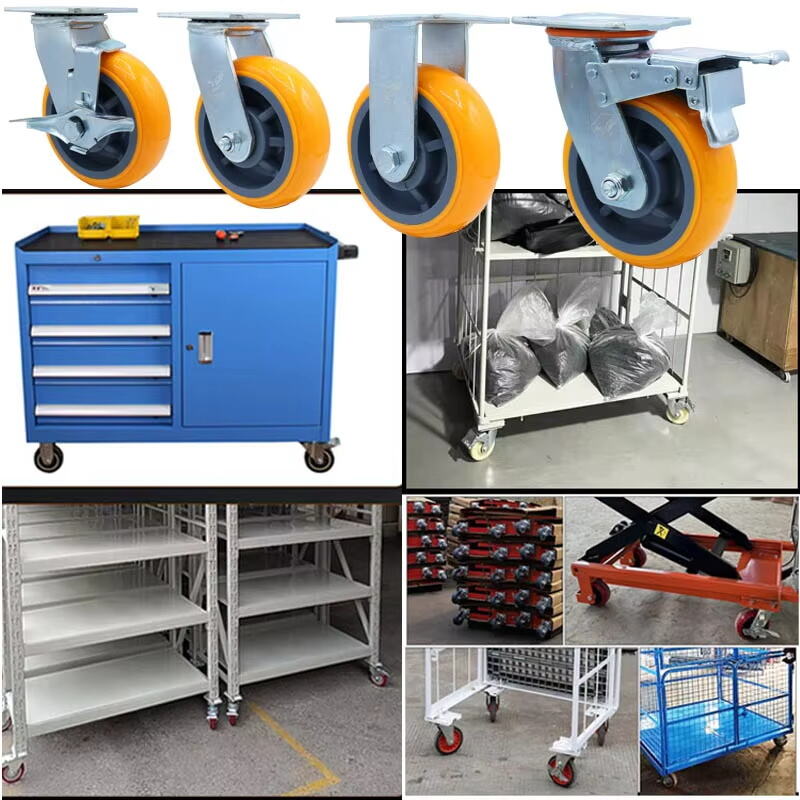Understanding Trolley Caster Wheel Load Requirements
Calculating Weight Distribution and Capacity
Picking out trolley caster wheels means getting a handle on how weight gets distributed across them for good performance and safety reasons. To figure out total load capacity, look at both the actual weight of whatever needs moving and how the trolley itself is built. There are formulas that help calculate all this properly, especially when dealing with multiple wheels where uneven distribution could overload one particular wheel. Some companies actually provide online tools that make these calculations much easier, giving quick estimates of what each setup can realistically handle without breaking down under stress.
Sticking to industry standards matters a lot when it comes to actual implementation because ignoring them usually leads to breakdowns down the road. Most professionals suggest building in a safety margin somewhere between 1.5 and 2 times whatever the anticipated load might be. Looking at what happens on factory floors across different sectors, we see time and again that these extra precautions really work wonders for preventing catastrophic failures while also making wheels last much longer than they otherwise would. The numbers don't lie either materials handling research keeps backing this up year after year.
Importance of Dynamic vs. Static Load Ratings
Picking the right trolley caster wheel means knowing what separates static from dynamic load ratings. Dynamic load ratings basically tell how well a wheel performs while moving around, something really important in places that never stop moving like manufacturing plants or big warehouses. On the flip side, static load ratings show just how much weight a wheel can hold without rolling at all. These matter most for setups where casters just sit there day after day without getting much action. Getting this distinction right makes all the difference between smooth operations and equipment failures down the road.
Selecting Wheel Material for Trolley Applications
Polyurethane vs. Nylon: Durability Comparison
When choosing between polyurethane and nylon wheels, understanding durability is crucial. Polyurethane wheels offer superior shock absorption, making them a preferred choice in warehouses and loading docks. Meanwhile, nylon wheels excel in environments with hard surfaces due to their excellent wear resistance.
Rubber Wheels for Floor Protection
Rubber wheels are crafted to prioritize floor protection, being essential for environments where maintaining floor integrity is vital, such as commercial and industrial spaces. Comparative studies have demonstrated that rubber wheels can significantly reduce floor wear, offering long-term savings on maintenance.
Metal Wheels for Extreme Environments
Metal wheels really stand out because they can handle heavy loads and keep going even when things get tough. Steel and cast iron wheels work best in those brutal situations we see in manufacturing plants or construction sites. Take a look at what happens on factory floors where rubber tires would wear out in days but metal ones last months longer. Industry reports show time and again that metal wheels beat alternatives in performance tests. This matters a lot when choosing equipment for demanding jobs. Companies need solutions that won't let them down during critical operations, which is why so many still rely on traditional metal wheel systems despite newer options coming onto the market.
Optimal Wheel Size and Configuration
Diameter Impact on Maneuverability
The diameter of a trolley caster wheel significantly impacts maneuverability. Larger wheels are generally better for navigating obstacles, providing smoother movement than smaller wheels. Common diameters range from 100mm to 200mm, varying based on application needs.
Tread Width for Stability and Floor Contact
Tread width plays a crucial role in the stability and floor contact of a cart. A wider tread enhances stability by distributing weight more evenly across the floor. Consulting with mechanical engineers can provide deeper insights into how tread width affects wheel performance and overall cart stability.
Environmental and Operational Factors
Floor Surface Compatibility
The compatibility of trolley caster wheels with different floor surfaces ensures optimal performance and prolongs lifespan. Various materials interact differently with surfaces like concrete, tile, or carpet. Conducting specific surface tests offers numerical comparisons, showcasing wheel materials' performance across diverse surfaces.
Chemical/Moisture Resistance Needs
Selecting wheel materials with chemical and moisture resistance is essential for enhancing longevity. Materials like polyurethane offer excellent resistance to chemicals, ensuring prolonged durability in chemically aggressive settings.
Temperature Tolerance Considerations
The temperature tolerance of trolley caster wheels influences both performance and safety. Each material has specific thresholds for high and low temperatures. Thermal resistance studies provide empirical data on how different materials hold up under heat and cold stress.
Bearing Types for Smooth Trolley Movement
Single vs. Double Ball Bearings
Choosing between single and double ball bearings hinges on load capacity and smoothness of movement. Double ball bearings are preferred for applications needing increased stability and higher load-bearing capacity, distributing the load more evenly.
Tapered Roller Bearings for Heavy Loads
Tapered roller bearings are essential for heavy loads, capable of handling both thrust and radial loads simultaneously. Performance benchmarks highlight their superior load ratings, making them highly effective in heavy-duty applications.

Brake Systems and Mounting Options
Swivel Lock vs. Total Lock Brakes
Understanding the differences between swivel and total lock brakes is essential for choosing the right brake systems for trolley casters. Swivel lock brakes offer enhanced maneuverability, whereas total lock brakes secure both wheel and swivel, providing maximum stability.
Plate vs. Stem Mounting Techniques
The choice between plate and stem mounting techniques impacts trolley wheel performance significantly. Plate mounting offers a wide surface area, perfect for heavy-duty applications, while stem mounting is more suitable for lighter applications.
FAQs
What is the importance of weight distribution in caster wheel selection?
Weight distribution is crucial for optimal performance and safety, preventing overloading any single wheel and extending wheel life.
Why are dynamic and static load ratings significant?
Dynamic load ratings are essential for environments requiring constant motion, while static load ratings are vital for stationary applications.
How do polyurethane wheels compare to nylon wheels?
Polyurethane wheels offer superior shock absorption, suited for varying surface textures, while nylon wheels excel on hard surfaces with excellent wear resistance.
What role do rubber wheels play in floor protection?
Rubber wheels reduce floor wear, essential for maintaining floor integrity and offering long-term savings on maintenance.
Which environments benefit most from metal wheels?
High-stress environments, particularly those involving extreme conditions, benefit most from the unmatched load capacity and durability of metal wheels.
Why are larger wheel diameters preferred?
Larger wheel diameters improve maneuverability over obstacles, providing smoother movement than smaller wheels.
How does tread width affect cart stability?
Wider treads enhance stability by distributing weight more evenly across the floor, preventing tipping and decreasing floor pressure.
What materials offer chemical and moisture resistance?
Materials like polyurethane and stainless steel offer excellent resistance, ensuring prolonged durability in chemically aggressive settings.
What factors influence the temperature tolerance of wheels?
Materials have specific thresholds for high and low temperatures, influencing wheel integrity and performance.
What benefits do double ball bearings offer?
Double ball bearings distribute load evenly, reducing friction and wear, preferred for applications needing increased stability.
Table of Contents
- Understanding Trolley Caster Wheel Load Requirements
- Selecting Wheel Material for Trolley Applications
- Optimal Wheel Size and Configuration
- Environmental and Operational Factors
- Bearing Types for Smooth Trolley Movement
- Brake Systems and Mounting Options
-
FAQs
- What is the importance of weight distribution in caster wheel selection?
- Why are dynamic and static load ratings significant?
- How do polyurethane wheels compare to nylon wheels?
- What role do rubber wheels play in floor protection?
- Which environments benefit most from metal wheels?
- Why are larger wheel diameters preferred?
- How does tread width affect cart stability?
- What materials offer chemical and moisture resistance?
- What factors influence the temperature tolerance of wheels?
- What benefits do double ball bearings offer?

